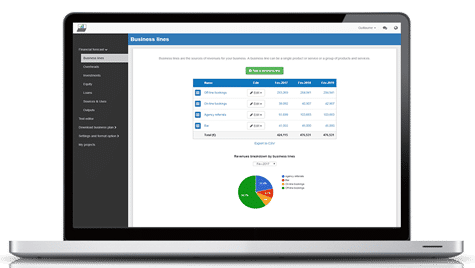How to create a financial forecast for a domestic appliance repair shop?
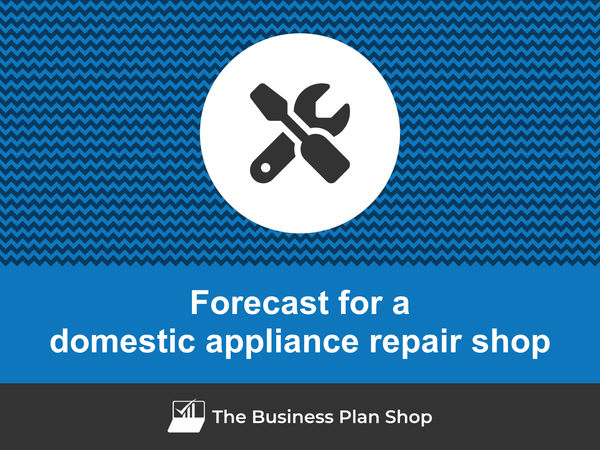
Creating a financial forecast for your domestic appliance repair shop, and ensuring it stays up to date, is the only way to maintain visibility on future cash flows.
This might sound complex, but with the right guidance and tools, creating an accurate financial forecast for your domestic appliance repair shop is not that hard.
In this guide, we'll cover everything from the main goal of a financial projection, the data you need as input, to the tables that compose it, and the tools that can help you build a forecast efficiently.
Without further ado, let us begin!
Why create and maintain a financial forecast for a domestic appliance repair shop?
The financial projections for your domestic appliance repair shop act as a financial blueprint to guide its growth with confidence and ensure its long-term financial viability.
To create them, you will need to look at your business in detail - from sales to operating costs and investments - to assess how much profit it can generate in the years to come and what will be the associated cash flows.
During challenging market conditions, maintaining an up-to-date financial forecast enables early detection of potential financial shortfalls, allowing for timely adjustments or securing financing before facing a cash crisis.
Your domestic appliance repair shop's financial forecast will also prove invaluable when seeking financing. Banks and investors will undoubtedly request a thorough examination of your financial figures, making precision and presentation essential.
Need a solid financial forecast?
The Business Plan Shop does the maths for you. Simply enter your revenues, costs and investments. Click save and our online tool builds a three-way forecast for you instantly.
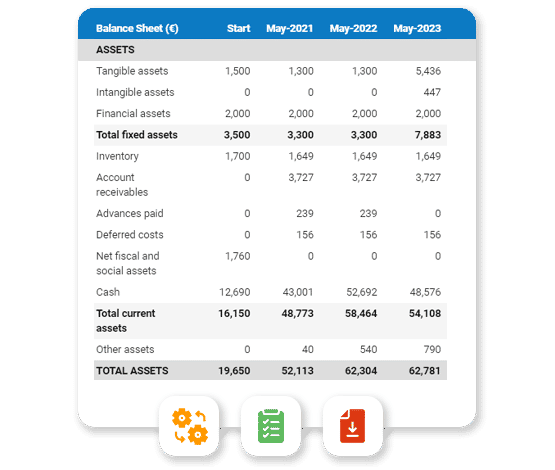
What information is used as input to build a domestic appliance repair shop financial forecast?
A domestic appliance repair shop's financial forecast is only as good as the inputs used to build it.
If you are creating (or updating) the forecast of an existing domestic appliance repair shop, then you mostly need your accounting information, key historical operating non-financial data, and your team’s input on what to expect for the coming years.
If you are building financial projections for a domestic appliance repair shop startup, you will need to have done your research and have a clear picture of your competitive environment and go-to-market strategy so that you can forecast sales accurately.
For a new venture, you will also need a precise list of the resources needed to keep the domestic appliance repair shop running on a day-to-day basis and a list of the equipment and expenditures required to start the business (more on that later).
Let's now take a closer look at the elements that make up your domestic appliance repair shop's financial forecast.
The sales forecast for a domestic appliance repair shop
From experience, it is usually best to start creating your domestic appliance repair shop financial forecast by your sales forecast.
To create an accurate sales forecast for your domestic appliance repair shop, you will have to rely on the data collected in your market research, or if you're running an existing domestic appliance repair shop, the historical data of the business, to estimate two key variables:
- The average price
- The number of monthly transactions
To get there, you will need to consider the following factors:
- Economic Conditions: The state of the economy can greatly impact the average price and number of monthly transactions for a domestic appliance repair shop. During times of economic downturn, people may choose to delay or forego repairs in order to save money. On the other hand, during times of economic prosperity, people may be more willing to spend money on repairs and upgrades, leading to an increase in average price and number of transactions.
- Competition: The level of competition in the local market can also affect your business's sales forecast. If there are many other repair shops in the area, you may need to lower your prices or offer promotions in order to stay competitive. This can lead to a decrease in your average price and potentially an increase in the number of transactions as customers are more likely to choose your shop over others. On the other hand, if you are the only repair shop in the area, you may be able to charge higher prices and still maintain a steady number of monthly transactions.
- Technological Advancements: As technology advances, the type of appliances people own and their repair needs may change. For example, if there is a shift towards more energy-efficient appliances, people may be less likely to need repairs and therefore your average price and number of transactions may decrease. However, if there is an increase in the use of smart home appliances, you may see an increase in the average price and number of transactions as these types of appliances often require specialized repairs.
- Seasonal Demand: The time of year can also affect your sales forecast. For a domestic appliance repair shop, there may be a higher demand for repairs during certain seasons. For example, the summer months may see an increase in repairs for air conditioning units, while the winter months may see an increase in repairs for heating systems. This can lead to fluctuations in your average price and number of transactions throughout the year.
- Customer Demographics: The demographics of your customer base can also play a role in your sales forecast. For example, if your shop is located in an area with a high percentage of older homeowners, you may see a higher demand for repairs on older appliances. This could result in a higher average price as these repairs may be more complex, but a lower number of monthly transactions as these customers may only need repairs on a few appliances. On the other hand, if your customer base is mostly young families, you may see a higher number of monthly transactions for smaller, simpler repairs on newer appliances, resulting in a lower average price.
Once you have an idea of what your future sales will look like, it will be time to work on your overhead budget. Let’s see what this entails.
Need inspiration for your business plan?
The Business Plan Shop has dozens of business plan templates that you can use to get a clear idea of what a complete business plan looks like.

The operating expenses for a domestic appliance repair shop
The next step is to estimate the expenses needed to run your domestic appliance repair shop on a day-to-day basis.
These will vary based on the level of sales expected, and the location and size of your business.
But your domestic appliance repair shop's operating expenses should include the following items at a minimum:
- Staff costs: This includes the salaries, wages, and benefits for your repair technicians, administrative staff, and any other employees.
- Accountancy fees: You may hire an accountant to handle your bookkeeping, tax filing, and other financial tasks.
- Insurance costs: As a repair shop, you will need insurance to protect your business against potential damages, liabilities, and lawsuits.
- Software licenses: You may need to purchase software licenses for programs such as accounting software, scheduling software, or inventory management software.
- Rent or lease: If you do not own your business space, you will need to pay rent or a lease for your repair shop.
- Utilities: This includes the costs of electricity, water, gas, and other utilities necessary to run your repair shop.
- Supplies and materials: You will need to purchase supplies and materials such as tools, replacement parts, and cleaning products for your repair work.
- Marketing and advertising: To attract customers, you may need to invest in marketing and advertising efforts, such as print ads, online ads, or flyers.
- Training and development: To stay up-to-date with the latest repair techniques and technologies, you may need to invest in training and development for your employees.
- Travel expenses: If you offer on-site repair services, you may need to cover travel expenses for your technicians.
- Professional fees: You may need to hire professionals for services such as legal advice, IT support, or equipment maintenance.
- Banking fees: This includes fees for bank accounts, credit card processing, and other financial services.
- Taxes and licenses: As a business owner, you will need to pay taxes and obtain necessary licenses and permits for your repair shop.
- Office expenses: This includes costs for office supplies, furniture, and equipment such as computers and printers.
- Repairs and maintenance: Just like your customers, your repair shop may also need repairs and maintenance for equipment, vehicles, or your business space.
This list is, of course, not exhaustive, and you'll have to adapt it according to your precise business model and size. A small domestic appliance repair shop might not have the same level of expenditure as a larger one, for example.
What investments are needed to start or grow a domestic appliance repair shop?
Creating and expanding a domestic appliance repair shop also requires investments which you need to factor into your financial forecast.
Capital expenditures and initial working capital items for a domestic appliance repair shop could include elements such as:
- Repair Equipment: This includes tools and machinery needed for repairing various domestic appliances such as washing machines, refrigerators, and ovens. These could include screwdrivers, pliers, multimeters, and other specialized equipment.
- Vehicle: A reliable vehicle is essential for a domestic appliance repair shop as it allows you to travel to clients' homes to provide on-site repairs. This could include a van or truck to transport equipment and supplies.
- Inventory: As a repair shop, you will need to keep a stock of spare parts and components for various appliances. This could include items such as motors, belts, and heating elements. Having a well-stocked inventory helps you provide efficient and timely repairs to your clients.
- Office Equipment: In addition to repair equipment, you will also need basic office equipment such as computers, printers, and phones. These are necessary for managing appointments, invoicing, and other administrative tasks.
- Workshop Space: If you plan on having a physical location for your repair shop, you will need to factor in the cost of renting or purchasing a suitable workshop space. This could include expenses such as rent, utilities, and maintenance.
Again, this list is not exhaustive and will need to be adjusted according to the circumstances of your domestic appliance repair shop.
Need a convincing business plan?
The Business Plan Shop makes it easy to create a financial forecast to assess the potential profitability of your projects, and write a business plan that’ll wow investors.
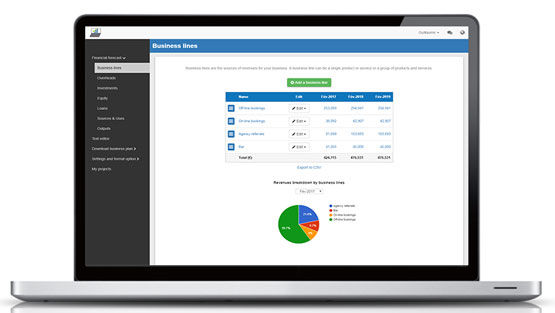
The financing plan of your domestic appliance repair shop
The next step in the creation of your financial forecast for your domestic appliance repair shop is to think about how you might finance your business.
You will have to assess how much capital will come from shareholders (equity) and how much can be secured through banks.
Bank loans will have to be modelled so that you can separate the interest expenses from the repayments of principal, and include all this data in your forecast.
Issuing share capital and obtaining a bank loan are two of the most common ways that entrepreneurs finance their businesses.
What tables compose the financial plan for a domestic appliance repair shop?
Now let's have a look at the main output tables of your domestic appliance repair shop's financial forecast.
The projected profit & loss statement
The projected profit & loss shows how profitable your domestic appliance repair shop is likely to be in the years to come.
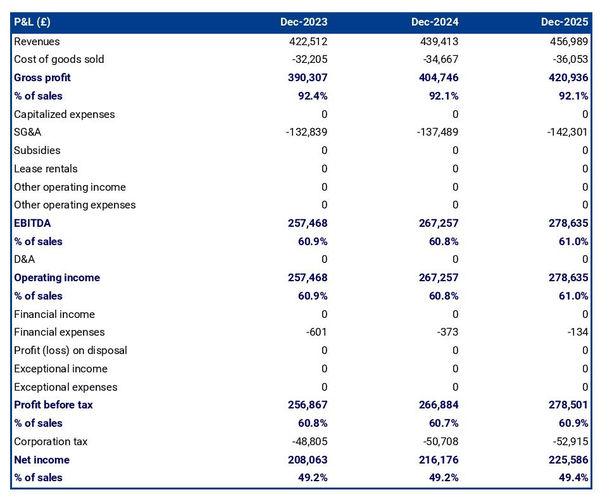
For your domestic appliance repair shop to be financially viable, your projected P&L should ideally show:
- Sales growing above inflation (the higher the better)
- Profit margins which are stable or expanding (the higher the better)
- A net profit at the end of each financial year (the higher the better)
This is for established domestic appliance repair shops, there is some leniency for startups which will have numbers that will look a bit different than existing businesses.
The projected balance sheet
The projected balance sheet gives an overview of your domestic appliance repair shop's financial structure at the end of the financial year.
It is composed of three categories of items: assets, liabilities and equity:
- Assets: are what the business possesses and uses to produce cash flows. It includes resources such as cash, buildings, equipment, and accounts receivable (money owed by clients).
- Liabilities: are the debts of your domestic appliance repair shop. They include accounts payable (money owed to suppliers), taxes due and bank loans.
- Equity: is the combination of what has been invested by the business owners and the cumulative profits to date (which are called retained earnings). Equity is a proxy for the value of the owner's stake in the business.
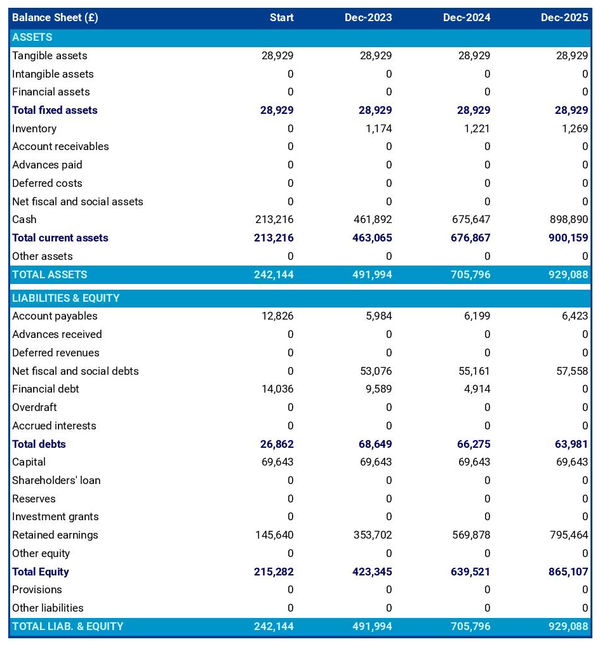
The projected cash flow statement
A projected cash flow statement for a domestic appliance repair shop is used to show how much cash the business is generating or consuming.

The cash flow forecast is usually organised by nature to show three key metrics:
- The operating cash flow: do the core business activities generate or consume cash?
- The investing cash flow: how much is the business investing in long-term assets (this is usually compared to the level of fixed assets on the balance sheet to assess whether the business is regularly maintaining and renewing its equipment)?
- The financing cash flow: is the business raising new financing or repaying financiers (debt repayment, dividends)?
Cash is king and keeping an eye on future cash flows is imperative for running a successful business. Therefore, you should pay close attention to your domestic appliance repair shop's cash flow forecast.
If you are trying to secure financing, note that it is customary to provide both yearly and monthly cash flow forecasts in a financial plan - so that the reader can analyze seasonal variation and ensure the domestic appliance repair shop is appropriately capitalised.
Need a solid financial forecast?
The Business Plan Shop does the maths for you. Simply enter your revenues, costs and investments. Click save and our online tool builds a three-way forecast for you instantly.

Which tool should you use to create your domestic appliance repair shop's financial forecast?
Using the right tool or solution will make the creation of your domestic appliance repair shop's financial forecast much easier than it sounds. Let’s explore the main options.
Using online financial forecasting software to build your domestic appliance repair shop's projections
The modern and easiest way is to use an online financial forecasting tool such as the one we offer at The Business Plan Shop.
There are several advantages to using specialised software:
- You can easily create your financial forecast by letting the software take care of the financial calculations for you without errors
- You have access to complete financial forecast templates
- You get a complete financial forecast ready to be sent to your bank or investors
- You can easily track your actual financial performance against your financial forecast, and recalibrate your forecast as the year goes by
- You can create scenarios to stress test your forecast's main assumptions
- You can easily update your forecast as time goes by to maintain visibility on future cash flows
- You have a friendly support team on standby to assist you when you are stuck
- It’s cost-efficient and much cheaper than using an accountant or consultant (see below)
If you are interested in this type of solution, you can try our projection software for free by signing up here.
Calling in a financial consultant or chartered accountant
Enlisting the help of a consultant or accountant is also a good way to obtain a professional domestic appliance repair shop financial forecast.
The downside of this solution is its cost. From experience, obtaining a simple financial forecast over three years (including a balance sheet, income statement, and cash flow statement) is likely to cost a minimum of £700 or $1,000.
The indicative cost above, is for a small business, and a forecast is done as a one-shot exercise. Using a consultant or accountant to track your actuals vs. forecast and to keep your financial projections up to date on a monthly or quarterly basis will cost a lot more.
If you opt for this solution, make sure your accountant has in-depth knowledge of your industry, so that they may challenge your figures and offer insights (as opposed to just taking your assumptions at face value to create the forecast).
Why not use a spreadsheet such as Excel or Google Sheets to build your domestic appliance repair shop's financial forecast?
Creating an accurate and error-free domestic appliance repair shop financial forecast with a spreadsheet is very technical and requires a deep knowledge of accounting and an understanding of financial modelling.
Very few business owners are financially savvy enough to be able to build a forecast themselves on Excel without making mistakes.
Lenders and investors know this, which is why forecasts created on Excel by the business owner are often frowned upon.
Having numbers one can trust is key when it comes to financial forecasting and to that end using software is much safer.
Using financial forecasting software is also faster than using a spreadsheet, and, with the rise of artificial intelligence, software is also becoming smarter at helping us analyse the numbers to make smarter decisions.
Finally, like everything with spreadsheets, tracking actuals vs. forecasts and keeping your projections up to date as the year progresses is manual, tedious, and error-prone. Whereas financial projection software like The Business Plan Shop is built for this.
Need a convincing business plan?
The Business Plan Shop makes it easy to create a financial forecast to assess the potential profitability of your projects, and write a business plan that’ll wow investors.

Use our financial projection templates for inspiration
The Business Plan Shop has dozens of financial forecast templates available.
Our examples contain a complete business plan with a financial forecast and a written presentation of the company, the team, the strategy, and the medium-term objectives.
Whether you are just starting out or already have your own domestic appliance repair shop, looking at our financial forecast template is a good way to:
- Understand what a complete business plan should look like
- Understand how you should model financial items for your domestic appliance repair shop
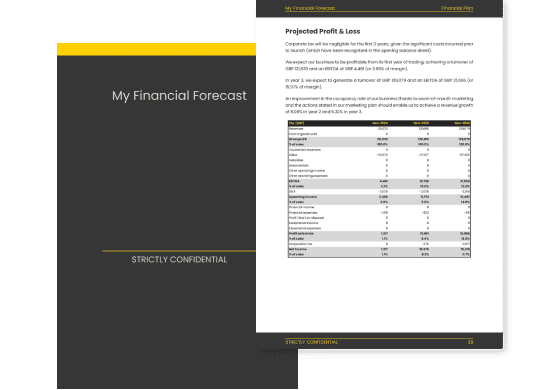
Takeaways
- A financial projection shows expected growth, profitability, and cash generation for your business over the next three to five years.
- Tracking actuals vs. forecast and keeping your financial forecast up-to-date is the only way to maintain visibility on future cash flows.
- Using financial forecasting software makes it easy to create and maintain up-to-date projections for your domestic appliance repair shop.
You have reached the end of our guide. We hope you now have a better understanding of how to create a financial forecast for a domestic appliance repair shop. Don't hesitate to contact our team if you have any questions or want to share your experience building forecasts!
Need inspiration for your business plan?
The Business Plan Shop has dozens of business plan templates that you can use to get a clear idea of what a complete business plan looks like.

Also on The Business Plan Shop
Know someone who runs or wants to start a domestic appliance repair shop? Share our financial projection guide with them!

